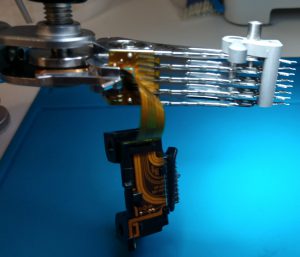We recently had a case where a 4.0TB Western Digital hard drive had been dropped. When a hard drive is dropped, the read/write heads are typically damaged and need to be replaced. In the best cases, there is no platter damage, but on average there is some damage, even if it’s just to the edge of the platters. In the worst case, the damage is so extensive that recovery efforts will most likely fail.
In this particular case, the heads were bent and stuck in the ramp. This is actually a good thing. In most cases after a hard drive is dropped, the user will power it back up to see if it still works. This can cause more damage and sometimes result in the data being scraped from the platters. When the heads get bent and stuck in the ramp, they can’t get back on the platters.
 Once the heads were inspected, it was clear that they were bent and would need a donor set to complete the recovery. You can read more about sourcing donor drives for Western Digital HDDs.
Once the heads were inspected, it was clear that they were bent and would need a donor set to complete the recovery. You can read more about sourcing donor drives for Western Digital HDDs.
In this particular case, 100% of the user data was recovered after a head swap.
If you have a dropped hard drive and the data is valuable, you should resist the urge to power on the drive. If you can’t resist, be prepared to power off the drive immediately if you hear any noise like clicking, scratching, buzzing, or even clanking. Don’t risk your data.
If you send your storage device in for recovery, please be sure to make a note that it was dropped.
Need your data back from a dropped hard disk drive? Send it in now for a flat rate recovery. We have a true “no data, no charge” policy. Review our very simple data recovery pricing structure so you can calculate the most it will cost before you send in your device for recovery.